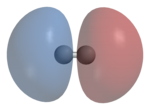משתמש:בנצי/ארגז חול ??: אנטי-קשר (להחליט על שם סופי / לברר)
תבנית:Ref improve תבנית:More footnotes

אנטי-קישור הינו סוג של קשר כימי. אורביטל אנטי-קושר (אנטי-קישור ואנטי-קושר - לברר + להחליט) הוא צורה של אורביטל מולקולרי (MO) הממוקם מחוץ לאזור של שני גרעינים אטומיים - לא ברור. החפיפה המתקבלת מהאורביטלים האטומיים המרכיבים את האורביטל המולקולרי הינה 'מהופכת מופע', ובתור שכזו, האלקטרונים המצויים בכל אורביטל אנטי-קושר הינם דוחים - לא ברור (אלק' תמיד דוחים ! ?) ופועלים לערעור יציבותה של המולקולה כיחידה אחת.
Antibonding (or anti-bonding) is a type of chemical bonding. An antibonding orbital is a form of molecular orbital (MO) that is located outside the region of two distinct nuclei.[1] The overlap of the constituent atomic orbitals is said to be out of phase, and as such the electrons present in each antibonding orbital are repulsive and act to destabilize the molecule as a whole.
Explanation[עריכת קוד מקור | עריכה]
Antibonding molecular orbitals (MOs) are normally higher in energy than bonding MOs. Bonding and antibonding orbitals form when atoms combine into molecules as a result of the Pauli Exclusion Principle. Consider two hydrogen atoms that are initially far apart and are brought together. When they are far apart and isolated, the atoms have identical energy levels. However, as the spacing between the two atoms becomes smaller, the electron wave functions begin to overlap. The Pauli principle dictates that no two electrons in an interacting system may have the same quantum state. Therefore, each energy level of the isolated atoms splits into two molecular orbitals belonging to the pair, one lower in energy than the original atomic level and one higher. For example, the ground state energy level, 1s, splits into two molecular orbitals. Since the lower orbital is lower in energy than the original atomic orbitals of the separate atoms, it is more stable, and promotes the bonding of the two H atoms into H2. This is the bonding orbital. The higher orbital is higher in energy than the original atomic orbitals and is less stable, and therefore opposes the bonding. This is the antibonding orbital. In a molecule such as H2, the two electrons normally occupy the bonding orbital, since it is lower in energy, and therefore the molecule is more stable than the separate H atoms.
A molecular orbital becomes antibonding when there is less electron density between the two nuclei than there would be if there were no bonding interaction at all. When an MO changes sign (from positive to negative) at a nodal plane between two atoms, it is said to be antibonding with respect to those atoms. Antibonding orbitals are often labelled with an asterisk (*) on molecular orbital diagrams.
In homonuclear diatomic molecules, σ* (sigma star) antibonding orbitals have no nodal planes passing through the two nuclei, like sigma bonds, and π* (pi star) orbitals have one nodal plane passing through the two nuclei, like pi bonds.
In molecules with several atoms, such as benzene, a particular MO may be bonding with respect to some adjacent pairs of atoms and antibonding with respect to other pairs. If the bonding interactions outnumber the antibonding interactions, the MO is said to be "bonding," whereas, if the antibonding interactions outnumber the bonding interactions, the MO is said to be "antibonding". Since each carbon atom contributes only one electron to the π-system of benzene, there are six π-electrons, and therefore only the three lowest-energy MOs (the bonding ones) are filled.
Another particular feature of antibonding is that the antibonding orbital is more antibonding than the bonding orbital is bonding. This leads to the conclusion that the energy of both MOs are raised by the presence of nucleus-nucleus repulsion.
Antibonding orbitals are also important for explaining chemical reactions in terms of molecular orbital theory. Roald Hoffmann and Kenichi Fukui shared the 1981 Nobel Prize in Chemistry for their work and further development of qualitative MO explanations for chemical reactions.
הערות שוליים[עריכת קוד מקור | עריכה]
- Atkins, P.W. (2002). Atkins Physical Chemistry. 7th ed. Oxford. ISBN 0-19-879285-9
- Orchin, M. Jaffe, H.H. (1967) The Importance of Antibonding Orbitals. Houghton Mifflin. ISBN B0006BPT5O
- The 1981 Nobel Prize in Chemistry
